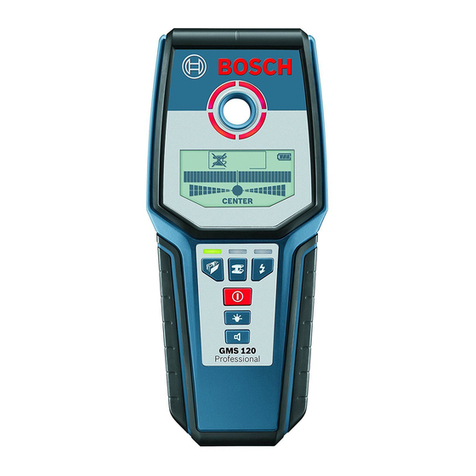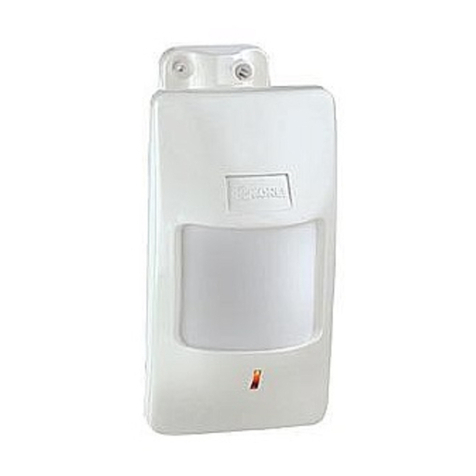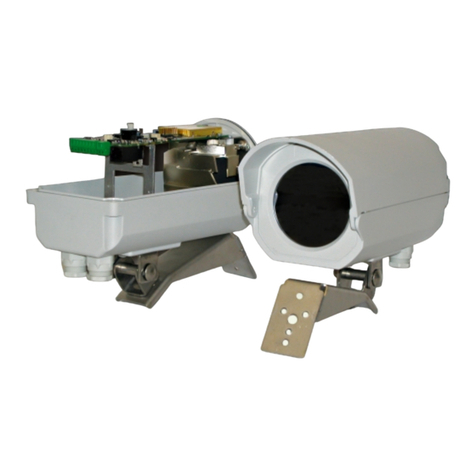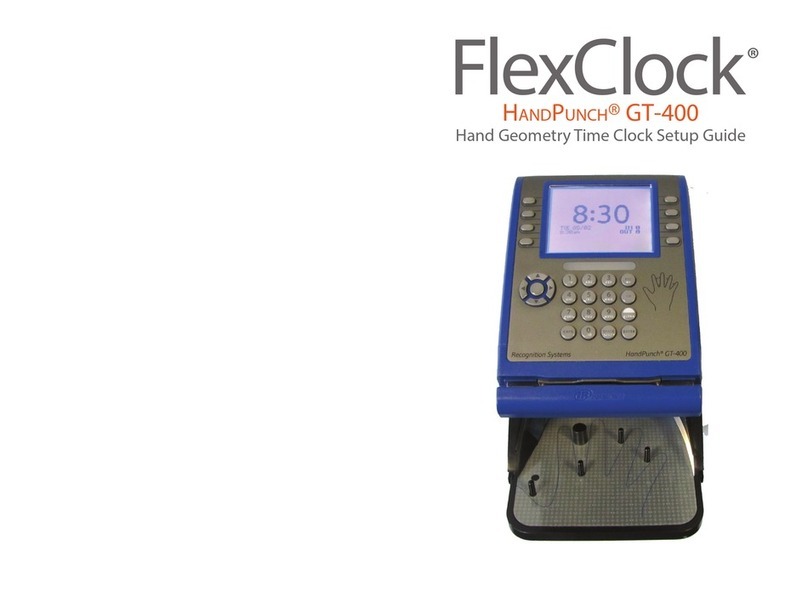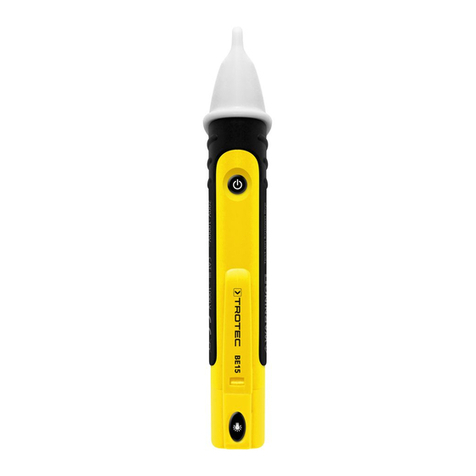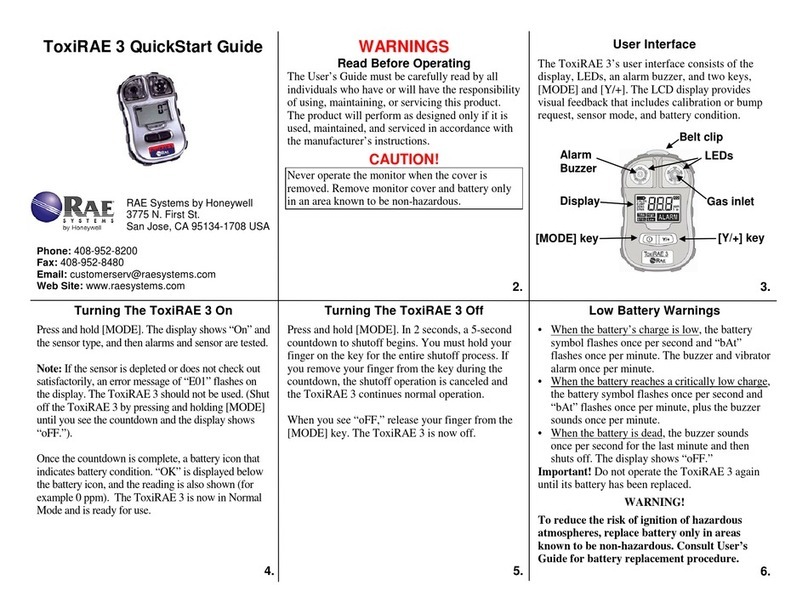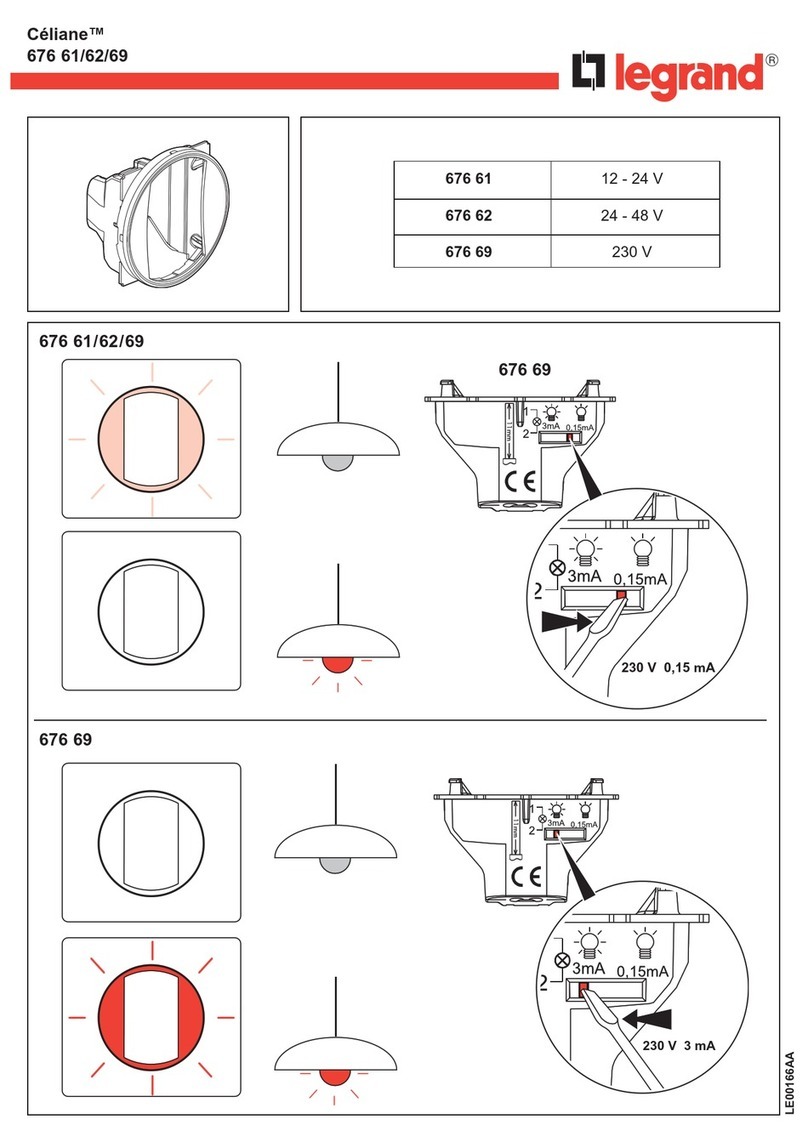GHM Delta OHM HD2013.3 User manual

Operating manual
Precipitation detector
HD2013.3
www.deltaohm.com
English
Keep for future reference.
Companies / Brands of GHM

HD2013.3 - 2 - V1.2
TABLE OF CONTENTS
1INTRODUCTION ..................................................................................... 3
2TECHNICAL SPECIFICATIONS................................................................. 4
3INSTALLATION ...................................................................................... 6
3.1ELECTRICAL CONNECTIONS ........................................................................6
4CONFIGURATION AND MEASUREMENT.................................................... 9
5PROPRIETARY PROTOCOL .....................................................................10
6MODBUS-RTU PROTOCOL ......................................................................16
7SAFETY INSTRUCTIONS.........................................................................19
8ORDERING CODES.................................................................................20

HD2013.3 - 3 - V1.2
1INTRODUCTION
HD2013.3 is a precipitation detector based on the capacitive principle. The capacity
value of the sensitive element changes according to the surface dampened by rain-
drops.
An integrated heater keeps the detector dry, evaporates water and prevents false sig-
nals caused by fog or dew. The heater also activates at low temperatures, melting the
snow and allowing detecting snow precipitations by using an ambient temperature
sensor.
The instrument external circular dome acts as a windshield for the sensor, preventing
false indications.
An auto-calibration algorithm compensates for variations in the response due to the
dirt that can accumulate on the sensitive surface.
The instrument has a digital RS485 output with MODBUS-RTU or proprietary protocol,
a 0/4…20 mA (0…10 V on request when ordering) analog output and a voltage-free
contact output. The contact output is activated when the sensor detects a precipita-
tion in progress.
The detector has IP68 protection degree.
Supplied with fixing bracket for ∅30…50 mm mast.
Optional bird spikes (to be requested when ordering the detector) can be mounted.

HD2013.3 - 4 - V1.2
2TECHNICAL SPECIFICATIONS
Precipitation sensor
Type Capacitive, with integrated heater
Dimensions 6.6 cm2
Angle 30°
Sensitive area 0.05 cm2min.
Temperature sensor NTC 10KΩ@ 25 °C
Measuring range
Precipitation detection ON / OFF (precipitation in progress / no precipitation)
Percentage of dry sensitive surface of the sensor
Temperature -40…+60 °C
Resolution
Precipitation detection Configurable 1 % (default) or 0.1 % of dry sensitive surface
of the sensor
Temperature 0.1 °C
Output RS485 not isolated, with MODBUS-RTU or proprietary protocol
Analog 0/4…20 mA (RLmax = 500 Ω) or on request 0…10 V
(RLmin = 10 kΩ)
Voltage-free normally open contact max. 200 mA @ 30 Vdc
resistive load
Power supply 12…30 Vdc
Consumption With heating OFF: 18 mA @24 Vdc
With heating ON: 230 mA max @24 Vdc
The indicated consumption does not include the consumption
due to the analog output
Connection 8-pole circular connector
Operating conditions -40…+60 °C / 0…100 %RH
Storage temperature -40…+60 °C
Dimensions ∅70 x 70 mm (only the instrument without mounting bracket)
Weight 450 g approx.
Protection degree IP 68
Housing material Technopolymer ASA

HD2013.3 - 5 - V1.2
Fig. 2.1: dimensions (mm)
Bird spikes (optional)
Bracket

HD2013.3 - 6 - V1.2
3INSTALLATION
Use the supplied accessories to mount the instrument. The bracket can be fixed to a ∅
30…50 mm mast, both vertical and horizontal, thanks to the double drilling on the
bracket.
Fig. 3.1: installation on vertical mast
Place the detector far from buildings, trees, etc…, taking care that the space above is
free from any object that could obstruct the detection of the precipitation. Keep the
sensor clean.
3.1 ELECTRICAL CONNECTIONS
The instrument has a 8-pole circular connector and uses the CP2013.2... optional ca-
bles, with 8-pole connector on one side and open wires on the other side.
Fig. 3.2: connectors pinout
HD2013.3
Bracket
Mast
Connector
Screws for fixing the
detector to the bracket
Ring for fixing the
bracket to the mast
Connector reference
Instrument male
connector (external view)
Cable female connecto
r
(external view)

HD2013.3 - 7 - V1.2
Connector Function Wire color
CP2013.2… cable
1 Voltage-free contact Green
2 Power supply positive (+Vdc) Red
3 RS485 B/+ White
4 Voltage-free contact Blue
5 RS485 A/- Brown
6 Analog output positive Yellow
7 Power supply negative (GND) Grey
8 Serial ground Black
To ensure a good noise immunity, it is recommended to connect the cable shield to
ground (GND).
RS485 connection:
By default, the instrument has MODBUS address 1and communication parameters
19200, 8E1. Different parameters can be set using the proprietary protocol or the
MODBUS-RTU protocol.
Fig. 3.3: RS485 connection
Current analog output:
By default, the current analog output is 4…20 mA, with:
4 mA = sensor sensitive surface completely wet
20 mA = sensor sensitive surface completely dry
With the commands of the proprietary protocol it is possible to set the range 0…20 mA
for the output and reverse the direction of the output, so that when the sensor sensi-
tive surface is completely wet the output is 20 mA.
In case of measurement error, the output goes to 22 mA.
Power supply
12…30 Vdc
Red
Grey
Brown
White
CP2013.2… cable
PLC, data logger o
r
RS485/USB or RS485/RS232
converter for PC
Othe
r
senso
r
s with
RS485 output
Termination
T
ermination

HD2013.3 - 8 - V1.2
Fig. 3.4: current analog output connection
Voltage analog output (optional):
By default, the voltage analog output is 0…10 V, with:
0 V = sensor sensitive surface completely wet
10 V = sensor sensitive surface completely dry
With the commands of the proprietary protocol it is possible to set the range 2…10 V
for the output and reverse the direction of the output, so that when the sensor sensi-
tive surface is completely wet the output is 10 V.
In case of measurement error, the output goes to 11 V.
Fig. 3.5: voltage analog output connection
Contact output:
There is a normally open voltage-free contact between pins 1 and 4 of the connector
(green and blue wires of the optional CP2013.2… cable). The contact closes when the
sensor detects a precipitation in progress.
Power supply 12…30 Vdc
CP2013.2… cable
Red
Grey
Yellow
Power supply 12…30 Vdc
CP2013.2… cable
Red
Grey
Yellow
R
Lmin = 10 kΩ
R
Lmax = 500 Ω

HD2013.3 - 9 - V1.2
4CONFIGURATION AND MEASUREMENT
The configuration of the instrument and the reading of the measurements can be done
via the RS485 serial output, both with the proprietary protocol and with the MODBUS-
RTU protocol.
In the first 10 seconds after the instrument power on, it is always active the proprie-
tary protocol. After 10 seconds from power on, the operating protocol is activated,
which by default is the MODBUS-RTU protocol.
It is possible to keep the proprietary protocol active even after 10 seconds from power on
by sending, before the 10 seconds expire, the command @of the proprietary protocol.
The proprietary protocol can be set as operating protocol by means of the CP0 command.
The commands of the proprietary protocol and the registers of the MODBUS-RTU pro-
tocol are described in detail in the following chapters.
Precipitation measurement:
To determine if a precipitation is in progress, the instrument detects the percentage of
dry sensitive surface of the sensor:
100% = sensitive surface of the sensor completely dry
0% = sensitive surface of the sensor completely wet
When the percentage of dry sensitive surface of the sensor falls below a configurable
threshold value (default 95%), the instrument indicates that a precipitation is in
progress. The threshold value can be modified with the command CRTnn of the
proprietary protocol or by using the holding register with address 5 of the MODBUS-
RTU protocol.
The indication of precipitation in progress ceases when the percentage of dry sensitive
surface of the sensor rises above the threshold plus a configurable hysteresis value
(default 2%) and after a configurable delay time (default 2 minutes).
The resolution with which the percentage of dry sensitive surface of the sensor is
detected is 1% by default. The resolution can be set to 0.1% with the command
CRLRn of the proprietary protocol or by using the holding register with address 16 of
the MODBUS-RTU protocol.
The instrument discriminates between rainfall and snowfall based on the measured
ambient temperature. If the ambient temperature is lower than a configurable
reference temperature (default 2 °C), the precipitation is considered snowy.
Automatic calibration of the precipitation sensor:
The instrument can be set so as the precipitation sensor calibration is automatically
performed at regular intervals; this allows compensating for any drift of the sensor
due to temperature changes, aging and dirt deposited on the sensitive surface.
The correction applied by each automatic calibration is limited to a maximum value
(configurable), so as to avoid erroneous calibrations when the detected value differs too
much from the estimated value.
By default, the automatic calibration is enabled, with 30 minutes interval and 0.1%
maximum correction. In order to change the automatic calibration settings, see the
chapters on the proprietary protocol and MODBUS-RTU protocol.

HD2013.3 - 10 - V1.2
5PROPRIETARY PROTOCOL
To use the proprietary protocol, it is necessary to connect the instrument to the PC via
a RS485/USB (e.g. RS51K) or RS485/RS232 converter and use a standard serial
communication program. In the serial communication program, set the COM port
number to which the instrument is connected and the communication parameters as
follows:
•If the MODBUS-RTU protocol is set as the operating protocol in the instrument
(default), set the Baud Rate 57600 and the parameters 8N2 in the serial commu-
nication program, then power cycle the instrument and send the command @
within 10 seconds from the instrument power on.
•If the proprietary protocol is already set as the operating protocol in the
instrument, it is possible to operate with Baud Rate 57600 and parameters 8N2
by sending the command @within 10 seconds from the instrument power on, or
you can let the 10 seconds pass without sending the command @and operate
with the communication parameters set in the instrument (default 19200, 8E1).
To change the instrument configuration, the serial command CAL USER ON must be
sent first (the instrument replies with USER CAL MODE ON). The command CAL USER ON
is automatically disabled after a few minutes of inactivity. If the settings should be only
read, the command CAL USER ON is not required.
Below is the list of the serial commands.
Instrument information:
Command Reply Description
G0 Model Instrument model
G1 &Revision| Instrument hardware revision
G2 SN=nnnnnnnn Instrument serial number
G3 Firm.Ver.=x.y Instrument firmware revision
G4 Firm.Date=yyyy/mm/dd Date of firmware revision
GC Fact.Calib.Date= yyyy/mm/dd Date of factory calibration
Protocol:
Command Reply Description
@ &| Keeps the proprietary protocol operational even after 10
seconds from instrument power on. It must be sent within
10 seconds from instrument power on.
CPn &| Sets the operating protocol:
Proprietary if n=0
MODBUS-RTU if n=1
Default : MODBUS-RTU (n=1)
RP & n| Reads the operating protocol set in the instrument.
SM &| Activates the MODBUS-RTU protocol immediately.
CMAn &| Sets the instrument address for the MODBUS-RTU pro-
tocol to n.
The address should range within 1 and 247.
Default : 1
RMA & n| Reads the instrument address for the MODBUS-RTU pro-
tocol.
Note: after sending the CP1 command, the instrument remains with the proprietary protocol.
Send the command SM to activate the MODBUS-RTU protocol immediately, or power cycle the

HD2013.3 - 11 - V1.2
instrument.
RS485 communication parameters:
Command Reply Description
CMBn &| Sets the Baud Rate:
1200 if n=0
2400 if n=1
4800 if n=2
9600 if n=3
19200 if n=4
38400 if n=5
57600 if n=6
115200 if n=7
Default : 19200 (n=4)
RMB & n| Reads Baud Rate setting
CMPn &| Sets parity and stop bits:
8N1 if n=0 [No parity, 1 stop bit]
8N2 if n=1 [No parity, 2 stop bits]
8E1 if n=2 [Even parity, 1 stop bit]
8E2 if n=3 [Even parity, 2 stop bits]
8O1 if n=4 [Odd parity, 1 stop bit]
8O2 if n=5 [Odd parity, 2 stop bits]
The number of data bits is fixed to 8.
Default : 8E1 (n=2)
RMP & n| Reads the setting of parity and stop bits.
CMWn &| Sets waiting time after transmission with MODBUS-RTU
protocol:
Immediate reception if n=0 (violates protocol)
Waiting 3.5 characters if n=1 (respects protocol)
Default : Immediate reception (n=0)
RMW & n| Reads the setting of waiting time after transmission with
MODBUS-RTU protocol.
Precipitation detection settings:
Command Reply Description
CRLRn &| Sets the resolution with which the percentage of dry
sensitive surface of the sensor is detected:
1% if n=0
0.1% if n=1
Default : 1% (n=0)
RRLR & n| Reads the resolution with which the percentage of dry
sensitive surface of the sensor is detected.
CRTn &| Sets the precipitation detection threshold to n value,
where n is the percentage of dry sensitive surface of the
sensor below which the instrument indicates that a
precipitation is in progress.
If the 0.1% resolution is set, the value must be ex-
pressed in tenths (for example, write 950 to indicate
95.0%).
Default : 95 (=95% with 1% default resolution)
RRT & n| Reads the setting of the precipitation detection thresh-
old.

HD2013.3 - 12 - V1.2
Command Reply Description
CRHn &| Sets the hysteresis of the precipitation detection thresh-
old to n value.
The value should range within 0 and 20%.
If the 0.1% resolution is set, the value must be ex-
pressed in tenths (for example, write 20 to indicate
2.0%).
Default : 2 (=2% with 1% default resolution)
RRH & n| Reads the setting of the hysteresis of the precipitation
detection threshold.
CSTn &| Sets the reference temperature to discriminate between
rainfall and snowfall to n value expressed in tenths of °C.
The value should range within -50 (=-5 .0 °C) and 50
(=+5.0 °C).
Default : 20 (=+2.0 °C)
RST & n| Reads the setting of the reference temperature to
discriminate between rainfall and snowfall.
CSHn &| Sets the hysteresis of the reference temperature to
discriminate between rainfall and snowfall to n value
expressed in tenths of °C.
The value should range within -5 (=-0 ,5 °C) and 5
(=+0,5 °C).
Default : 5 (=+0,5 °C)
RSH & n| Reads the setting of the hysteresis of the reference
temperature to discriminate between rainfall and
snowfall.
CRADn &| Sets the delay in indicating the beginning of a precipita-
tion, both rainy and snowy, to n seconds (0…32767 s).
The indication of precipitation in progress is generated
only if the precipitation lasts longer than the set time.
Default: 0
RRAD & n| Reads the setting of the delay in indicating the beginning
a precipitation.
CRABn &| Sets the delay in indicating the end of a precipitation,
both rainy and snowy, to n seconds (0…32767 s).
The indication of precipitation in progress ceases only af-
ter the set time has elapsed from the end of the precipita-
tion.
Default: 120
RRAB & n| Reads the setting of the delay in indicating the end of a
precipitation.
CTADn &| Sets the delay in indicating the transition from rainfall to
snowfall, when the temperature dops below the reference
temperature, to n seconds (0…32767 s).
Default: 0
RTAD & n| Reads the setting of the delay in indicating the transition
from rainfall to snowfall, when the temperature dops be-
low the reference temperature.

HD2013.3 - 13 - V1.2
Command Reply Description
CTABn &| Sets the delay in indicating the transition from snowfall
to rainfall, when the temperature rises above the refer-
ence temperature plus the hysteresis, to n seconds
(0…32767 s).
Default: 0
RTAB & n| Reads the setting of the delay in indicating the transition
from snowfall to rainfall, when the temperature rises
above the reference temperature plus the hysteresis.
Contact output:
Command Reply Description
CRSn &| Sets the contact output activation mode:
Output disabled if n=0
Output activated in case of rainfall if n=1
Output activated in case of snowfall if n=2
Note: the precipitation is considered a rainfall if the
measured temperature is higher than the reference
temperature, and a snowfall if the measured tempera-
ture is lower than the reference temperature.
Default : Output activated in case of rainfall (n=1)
RRS & n| Reads the setting of the contact output activation mode.
Analog output:
Command Reply Description
CAOE &| Adds the offset to the analog output: 4…20 mA or 2…10 V.
CAOD &| Remove the offset from the analog output: 0…20 mA or
0…10 V.
CAOR & n| Reads the setting of the offset for the analog output:
Without offset if n=0 (default for voltage output)
With offset if n=1 (default for current output)
CASE &| Sets the following correspondence for the analog output:
4 mA / 0 V ⇒100% of dry sensitive surface
20 mA / 10 V ⇒0% of dry sensitive surface
CASD &| Sets the following correspondence for the analog output:
4 mA / 0 V ⇒0% of dry sensitive surface
20 mA / 10 V ⇒100% of dry sensitive surface
CASR & n| Reads the setting of the correspondence between analog
output and percentage of dry sensitive surface:
4…20 mA / 0…10 V ⇒0…100% if n=0 (default)
4…20 mA / 0…10 V ⇒100…0% if n=1

HD2013.3 - 14 - V1.2
Units of measurement:
Command Reply Description
TTn &| Sets the temperature unit of measurement:
°C if n=0
°F if n=1
Default : °C (n=0)
HH & n| Reads the setting of the temperature unit of
measurement.
Reading of the measurement information:
Command Reply Description
S0 &| Disable the sending of the measurement informa-
tion.
S1 &| Enable the sending of the measurement informa-
tion at regular intervals.
To set the sending interval, use the command MT.
For the meaning of the information sent by the
instrument, see the command S2.
S2 & RAIN_RAW
RAIN_LEVEL
RAIN_STATUS
RAIN_VALIDITY
PRECIPITATION_TYPE
AMB_TEMP VOLTAGE
HEATER_TEMP
MICRO_TEMP
HEATER_MODE
HEATER_PERCENTAGE|
Prints the list of the measurement information
sent by the instrument:
RAIN_RAW = number of 12-bit ADC counts,
proportional to the percentage of dry sensitive
surface of the sensor
RAIN_LEVEL = percentage of dry sensitive surface
of the sensor
RAIN_STATUS = indication of no precipitation (0)
or precipitation in progress (1)
RAIN_VALIDITY = validity of the precipitation
indication (0=no, 1=yes)
PRECIPITATION_TYPE = indication of the type of
precipitation (0=rainfall, 1=snowfall)
AMB_TEMP = ambient temperature
VOLTAGE = power supply voltage
HEATER_TEMP = heater temperature
MICRO_TEMP = internal board temperature
HEATER_MODE = heating operating mode
HEATER_PERCENTAGE = percentage of heating
power used
MTn &| Sets the interval for sending the measurement in-
formation to n seconds (1…30 s).
Default: 1
NT & n| Reads the setting of the interval for sending the
measurement information.

HD2013.3 - 15 - V1.2
Heating:
Command Reply Description
CHMn &| Sets the heating operating mode:
Manual if n=0
Always on if n=1
Always off if n=2
Automatic if n=3
If the manual mode is set, the heating power set with
the command CHP is used.
Default : Automatic (n=3)
RHM & n| Reads the setting of the heating operating mode.
CHPn &| Sets the heating power for the manual operating mode
to n value, as a percentage of the maximum power
(0…100%)
Default : 50 (=50% of the maximum power)
RHP & n| Reads the setting of the heating power for the manual
operating mode.
Advanced functions:
Command Reply Description
DFLT &| Restores the factory configuration.
CU4 &| Calibrates the instrument.
Send the command only if the sensor sensitive surface
is completely dry.
CRBSn &| Enable/disable the precipitation sensor automatic cali-
bration at regular intervals:
Disable if n=0
Enable if n=1
Default : Automatic calibration enabled
RRBS & n| Reads the enabling status of the precipitation sensor au-
tomatic calibration.
CRBTn &| Sets the time interval between two consecutive precipi-
tation sensor automatic calibrations to n seconds
(300…64800 s).
Default: 1800 (=30 minutes)
RRBT & n| Reads the setting of the time interval between two con-
secutive precipitation sensor automatic calibrations.
CRBMCn &| Sets the maximum correction that can be applied by each
precipitation sensor automatic calibration to n value
expressed in tenths of %.
The value should range within 1 (=0.1%) and 200
(=20.0%).
Default: 1 (=0.1%)
RRBMC & n| Reads the maximum correction that can be applied by
each precipitation sensor automatic calibration.
GRC & x y| Reads the number of reboots (x) and watchdog timeouts
(y) that occurred.

HD2013.3 - 16 - V1.2
6MODBUS-RTU PROTOCOL
By default, the instrument has MODBUS address 1and communication parameters
19200, 8E1. The address and the communication parameters can be changed by using
the appropriate serial commands of the proprietary protocol or, alternatively, directly
with MODBUS commands by changing the value of the Holding Registers described
later.
The MODBUS-RTU protocol, if set as the operating protocol (default), is active after 10
seconds from the instrument power on.
In order to change the instrument configuration using the MODBUS-RTU protocol, the
value 1 must be written first in the Coil number 2 (address 1).
Below is the list of registers (the tables show both the number and the address of the
registers, with the address of the register equal to the number of the register
decreased by 1, as defined in the MODBUS standard).
Discrete inputs:
Number Address Description Format
1 0
Indication of no precipitation (0) or precipitation in
progress (1).
Bit
2 1 Validity of the precipitation indication: 0=no, 1=yes. Bit
3 2
Indication of the type of precipitation:
0=rainfall, 1=snowfall.
Bit
Input Registers:
Number Address Description Format
1 0 Instrument model identification. 16-bit Integer
2 1 Instrument hardware revision. 16-bit Integer
3,4 2,3 Instrument serial number.
(*) 16-bit Integer
5 4
Instrument firmware revision. The most si
g
nificant b
y
te
indicates the major revision; the less significant byte
indicates the minor revision.
16-bit Integer
6 5 Number of reboots that occurred. 16-bit Integer
7 6 Number of watchdog timeouts that occurred. 16-bit Integer
8 7 Power supply voltage in Volt (x10). 16-bit Integer
9 8 Internal board temperature (x10). 16-bit Integer
10 9
Number of 12-bit ADC counts, proportional to the
percentage of dry sensitive surface of the sensor.
16-bit Integer
11 10
Percentage of dry sensitive surface of the sensor (x10
if the resolution is 0.1%).
16-bit Integer
12 11 Number of MODBUS communication error. 16-bit Integer
13 12 Ambient temperature (x10). 16-bit Integer
14 13 Heater temperature (x10). 16-bit Integer
15 14 Percentage of heating power used. 16-bit Integer
(*) The Instrument serial number has 8 digits. Two consecutive registers must be accessed to
read the number. The register with lower address contains the most significant 4 digits.

HD2013.3 - 17 - V1.2
Coils:
Number Address Description Format
1 0
Set 1 to restore the factory configuration. Bit zeroing
is automatic.
Bit
2 1
Enable configuration change:
0=no (default), 1=yes.
The changes to Coils and Holding Registers will be ac-
cepted only if this register is set to 1.
Bit
3 2
Sets waiting time after transmission with MODBUS-RTU
protocol:
0=immediate reception (default);
1=waiting 3.5 characters.
Bit
4 3
Set 1 to calibrate the instrument. Bit zeroing is auto-
matic.
Set 1 only if the sensor sensitive surface is completely
dry.
Bit
Holding Registers:
Number Address Description Format
1 0
RS485 Baud Rate:
0=1200;
1=2400;
2=4800;
3=9600;
4=19200 (default);
5=38400;
6=57600;
7=115200.
16-bit Integer
2 1
RS485 parity and stop bits:
0=8N1;
1=8N2;
2=8E1 (default);
3=8E2;
4=8O1;
5=8O2.
[N=no parity, E=even parity, O=odd parity]
16-bit Integer
3 2
Instrument address for the MODBUS-RTU protocol
(1…247, default=1).
16-bit Integer
4 3
Heating operating mode:
0= Manual;
1= Always on;
2= Always off;
3= Automatic (default).
If the manual mode is set, the heating power set in
the next register is used.
16-bit Integer
5 4
Heating power for the manual operating mode as a
percentage of the maximum power (default=50%).
16-bit Integer
6 5
Precipitation detection threshold as a percentage (x10
if the resolution is 0.1%) of dry sensitive surface of the
sensor below which the instrument indicates that a
precipitation is in progress (default=95%).
16-bit Integer

HD2013.3 - 18 - V1.2
Number Address Description Format
7 6
Hysteresis (x10 if the resolution is 0.1%) of the pre-
cipitation detection threshold (0…20%, default=2%).
16-bit Integer
8 7 Precipitation detection interval (1…30 s, default=1 s). 16-bit Integer
9 8
Reference temperature, expressed in tenths of the set
unit of measurement, to discriminate between rainfall
and snowfall (-50…+50=-5.0…+5.0 °C, default=+2.0
°C).
16-bit Integer
10 9
Hysteresis of the reference temperature, expressed in
tenths of the set unit of measurement, to discriminate
between rainfall and snowfall (-5…+5=-0.5…+0.5 °C,
default=+0.5).
16-bit Integer
11 10
Delay in indicating the beginning of a precipitation,
both rainy and snowy (0…32767 s, default 0).
The indication of precipitation in progress is generated
only if the precipitation lasts longer than the set time.
16-bit Integer
12 11
Delay in indicating the end of a precipitation, both
rainy and snowy (0…32767 s, default 120 s).
The indication of precipitation in progress ceases only
after the set time has elapsed from the end of the pre-
cipitation.
16-bit Integer
13 12
Delay in indicating the transition from rainfall to snow-
fall, when the temperature dops below the reference
temperature (0…32767 s, default 0).
16-bit Integer
14 13
Delay in indicating the transition from snowfall to rain-
fall, when the temperature rises above the reference
temperature plus the hysteresis (0…32767 s, default
0).
16-bit Integer
15 14 Temperature unit of measurement: 0=°C, 1=°F. 16-bit Integer
16 15
Contact output activation mode:
0= Output disabled;
1= Output activated in case of rainfall (default);
2= Output activated in case of snowfall.
Note: the precipitation is considered a rainfall if the
measured temperature is higher than the reference
temperature, and a snowfall if the measured tempera-
ture is lower than the reference temperature.
16-bit Integer
17 16
Resolution with which the percentage of dry sensitive
surface of the sensor is detected:
0= 1% (default); 1= 0.1%.
16-bit Integer
18 17
Enable the precipitation sensor automatic calibration
at regular intervals: 0=no, 1=yes (default).
16-bit Integer
19 18
Time interval between two consecutive precipitation
sensor automatic calibrations (300…64800 s, default
1800=30 minutes).
16-bit Integer
20 19
Maximum correction that can be applied by each pre-
cipitation sensor automatic calibration expressed in
tenths of % (1…200=0.1…20.0%, default=1).
16-bit Integer

HD2013.3 - 19 - V1.2
7SAFETY INSTRUCTIONS
General safety instructions
The instrument has been manufactured and tested in accordance with the safety
standard EN61010-1:2010 “Safety requirements for electrical equipment for meas-
urement, control and laboratory use” and has left the factory in perfect safety techni-
cal conditions.
The instrument proper operation and operating safety can be ensured only if all stan-
dard safety measures as well as the specific measures described in this manual are
followed.
The instrument proper operation and operating safety can be ensured only in the cli-
matic conditions specified in this manual.
Do not use the instruments in places where there are:
•Corrosive or flammable gases.
•Direct vibrations or shocks to the instrument.
•High-intensity electromagnetic fields, static electricity.
User obligations
The instrument operator shall follow the directives and regulations below that refer to
the treatment of dangerous materials:
•EEC directives on workplace safety.
•National law regulations on workplace safety.
•Accident prevention regulations.

HD2013.3 - 20 - V1.2
8ORDERING CODES
HD2013.3 Rainfall/snowfall detector. IP68. RS485 output with MODBUS-RTU
or proprietary protocol, 0/4…20 mA (0…10 V on request when
ordering) analog output and voltage-free contact output. Sup-
plied with mounting bracket and 8-pole watertight female free
connector. Optional bird spikes (to be requested when order-
ing). CP2013.2… cable has to be ordered separately.
HD2013.2D Bird spikes (6 spikes ∅3 mm, height 60 mm). To be requested
when ordering the instrument.
CP2013.2.5 Cable with 8-pole watertight connector on one end, free wires on
the other end. Length 5 m.
CP2013.2.10 Cable with 8-pole watertight connector on one end, free wires on
the other end. Length 10 m.
DELTA OHM metrology laboratories LAT N° 124 are ISO/IEC 17025 accredited by
ACCREDIA for Temperature, Humidity, Pressure, Photometry / Radiometry, Acous-
tics and Air Velocity. They can supply calibration certificates for the accredited
quantities.
This manual suits for next models
1
Table of contents
Popular Security Sensor manuals by other brands
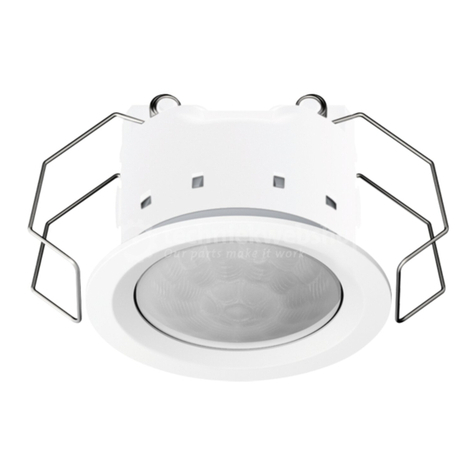
Jung
Jung Mini basic operating instructions
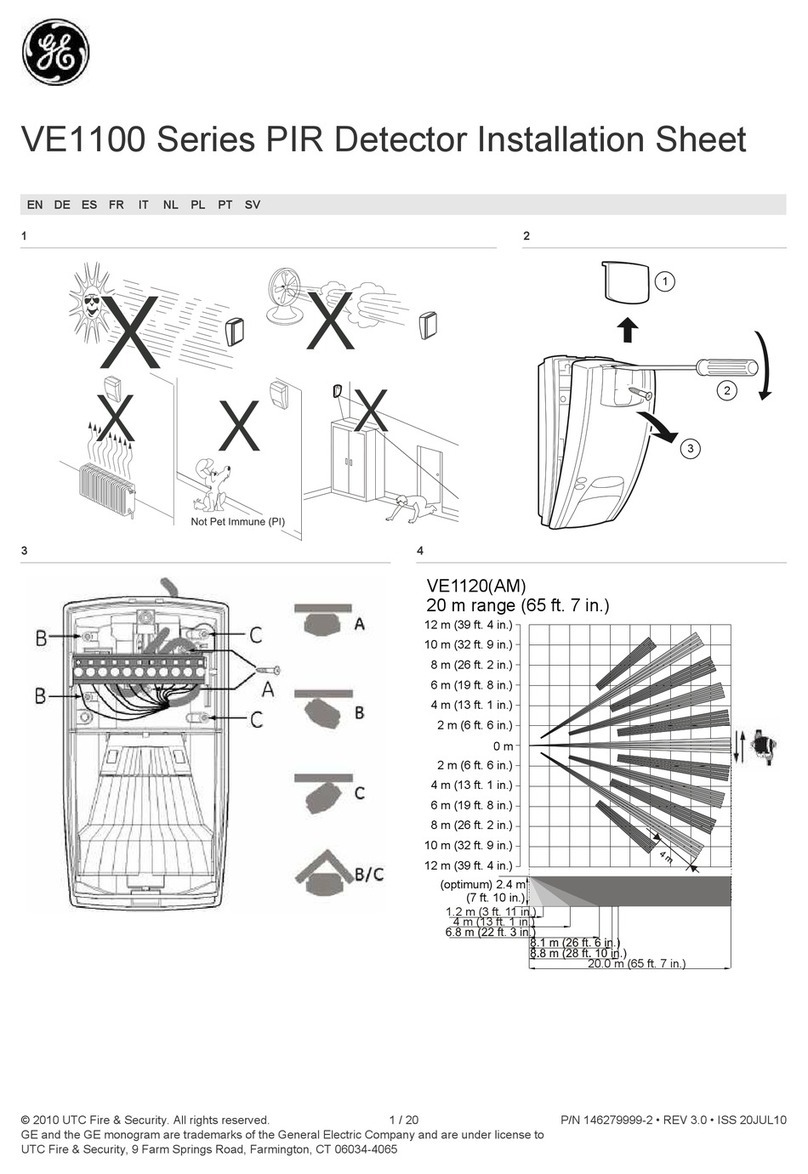
GE
GE VE1100 Series Installation sheet
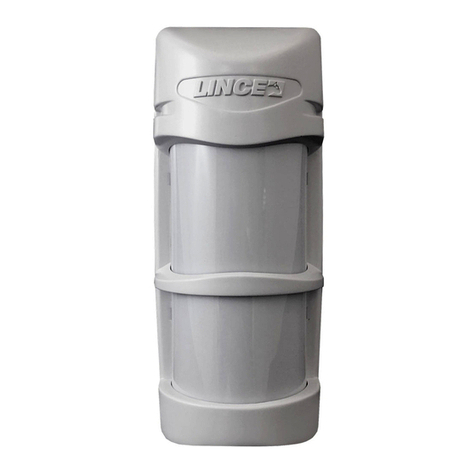
Lince
Lince Sigma 1946-BOBBY180-24-AM-V Installation, operation and maintenance manual
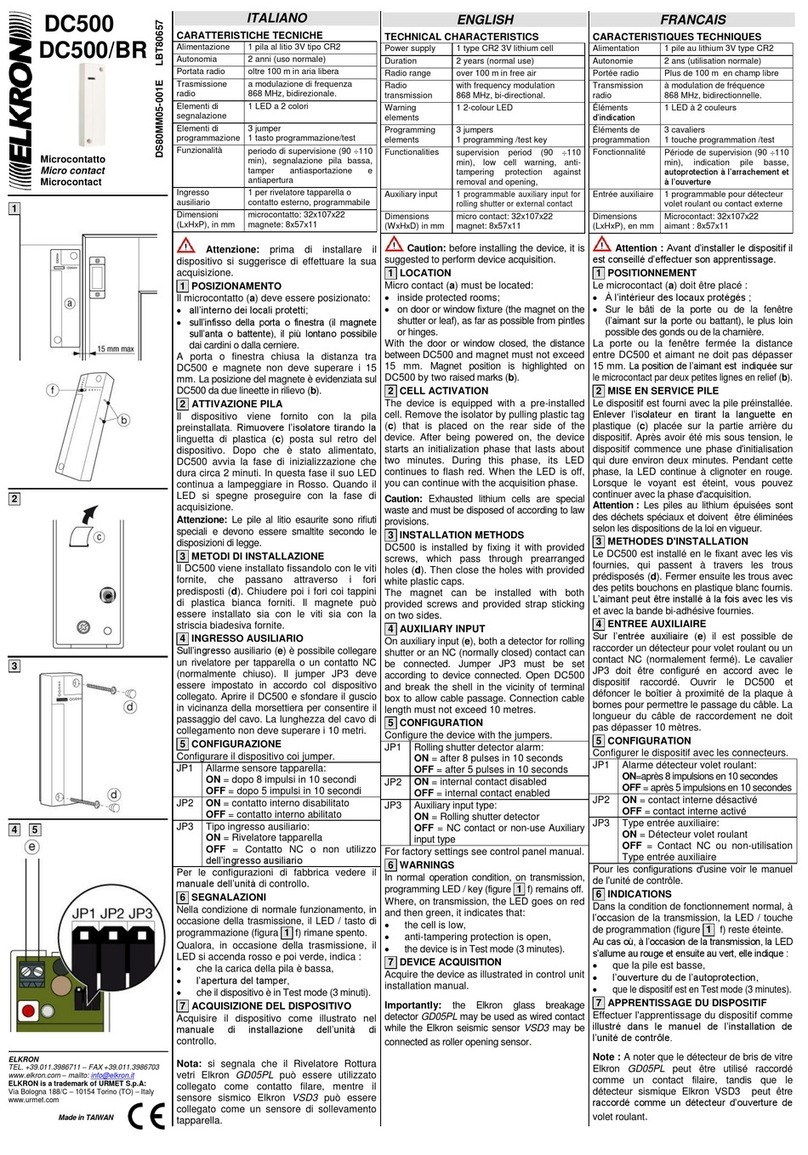
Elkron
Elkron DC500 quick start guide
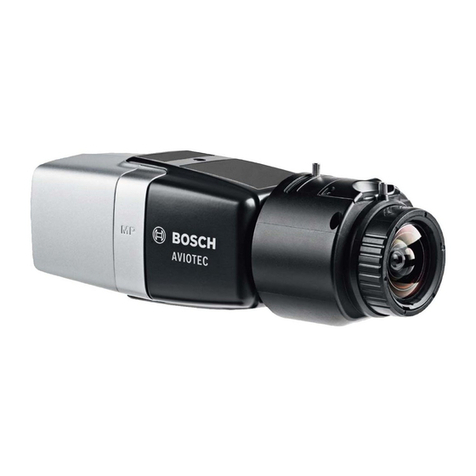
Bosch
Bosch AVIOTEC IPSTARLIGHT 8000 Planning Manual
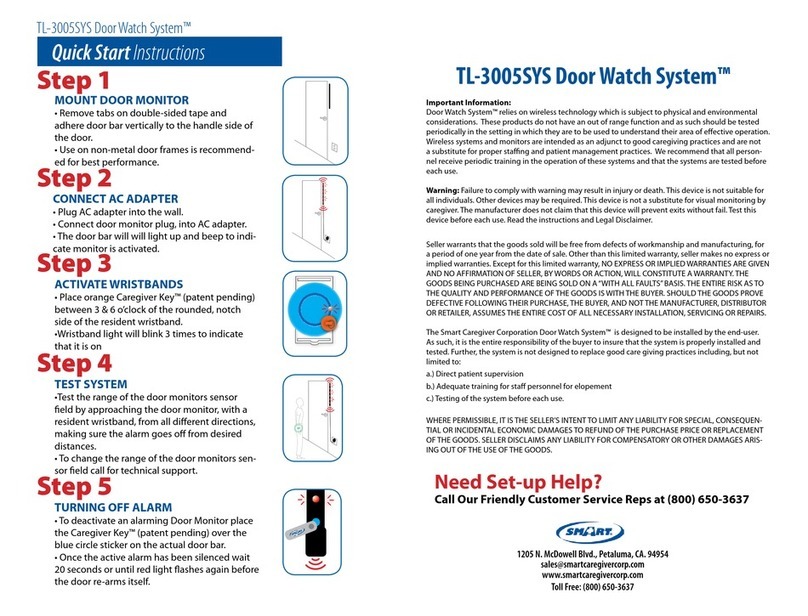
SMART
SMART TL-3005SYS Door Watch System installation instructions
